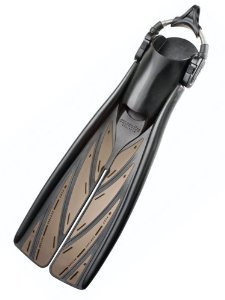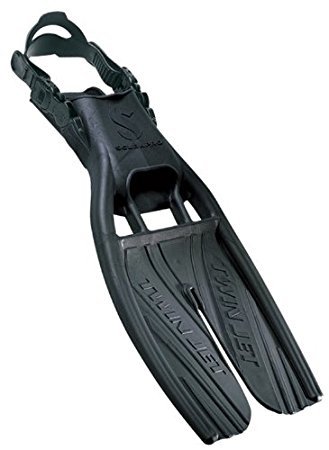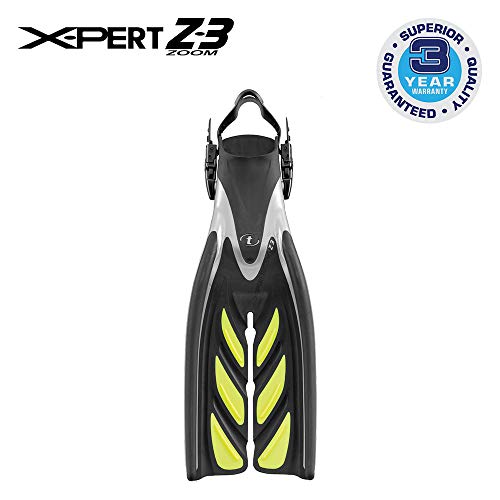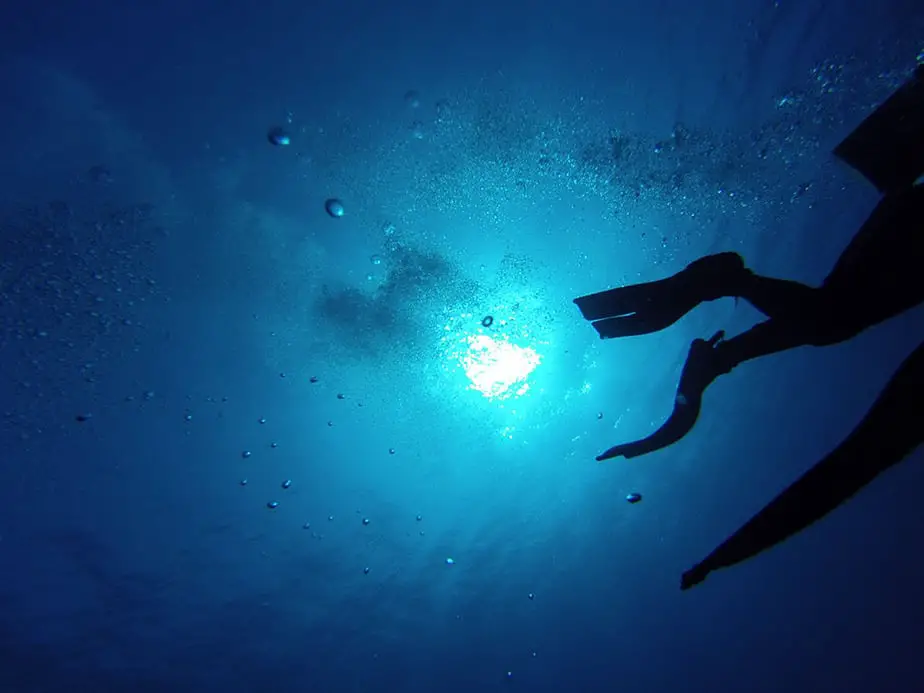Traditional paddle fins have been around for over a century, having been designed in the early 1900s and receiving many iterations over the years. One such design that started gaining popularity in the late 90s is the split fin. Fins are used in a variety of water-sports including SCUBA diving and snorkeling, and the question we are going to answer in this article is are split fins good for snorkeling? Or are paddle fins still the gold standard when it comes to fin design?
Split fins – are they an overrated gimmick, or are they a legitimate contender for the new best snorkeling fin? In order to answer this, one must first consider the pros and cons of each fin type, as well as what kinds of activities one plans on using the fins for. We feel that both split fins and paddle fins have their uses, and whether you like one over the other depends on your personal preference.
Paddle Fins Overview
When you think of fins, the image you conjure up is most likely a traditional, single blade paddle fin. They are usually made with durable and stiffer plastic materials. You can find ones made from stiff, heavy rubber as well as ones made from softer, pliable rubber that helps them to be more flexible.
Both stiff and flexible paddle fins are common and desired by different SCUBA divers and snorkelers depending on the divers’ preference.
Paddle Fin Pros
- Paddle fins provide more thrust with each kick. Since they are generally made from stiff rubber, it helps generate a greater amount of propulsion with each kick, allowing divers and snorkelers to cover more ground but requiring more strength to use.
- Paddle fins can help you swim against rough currents. Expanding on the point above, if you are heading out in rough waters, then you should use paddle fins to help you fight against the strong currents. Split fins would not fare as well against strong currents.
- They are better for diver rescues. Should you ever need to dive underwater to rescue someone, paddle fins are better suited than split fins. When towing someone back to the boat or to shore, you need strong load-bearing fins and stiff paddle fins are up for that task.
- They provide superior maneuverability in small spaces, making them optimal for cavern, cave, and wreck dives.
- They are usable with numerous kicking styles.
Paddle Fin Cons
- Paddle fins are bulkier and heavier than split fins. Most paddle fins are constructed from stiff plastic, whereas the split fin design necessitates more pliable and lighter materials.
- Paddle fins are harder to kick with. Expanding on the point above, due to their stiffness and bulk, one must have greater endurance and a stronger kick to maneuver with paddle fins. Furthermore, they can cause ankle and calf cramping from the force needed to kick with them.
Split Fins Overview
The split fin is the new kid on the block, arriving on the scene in the late 90s to compete with the tried and true paddle fin. It is called a split fin because of how the fin is split down the middle. This design allows it to slice through water more easily than a paddle fin.
This is the strength of the split fin; since they split through water with less resistance, one can kick faster and perform more kicks overall, whereas paddle fins generate more thrust with each kick but each kick requires more effort.
Split Fin Pros
- Split fins are optimal for snorkelers and divers that prefer to flutter kick or bicycle kick. For those who dislike performing large, straight-legged kicks, the main advantage of split fins is how fast you can kick with them. The goal is to make the diver or snorkeler more streamlined by keeping the fins inline with the body.
- They are constructed from pliable and more flexible rubber which makes them easier to kick with. Snorkelers who want a more comfortable fin that can also lower ankle fatigue, calf cramping, and muscle fatigue should lean towards split fins.
- Better suited for long snorkels and dives. Since the split design slices through water easily, the split fins cause less fatigue on the diver and helps them conserve energy.
Split Fin Cons
- Not suitable for tech divers. For advanced divers that like to utilize various kicks such as frog kicking, turning, and backing up, they cannot compare with paddle fins. For such maneuvering, the fins should be stiffer to generate more force in a tight space.
- They do not generate as much thrust per kick. They are designed for rapid kicks, and that makes them suboptimal under load, such as when swimming against strong currents or carrying someone or something heavy.
- Can be outkicked. If you have powerful legs, there comes a point where you can kick so hard and fast but not not go any faster, kind of like how futile it is to fan a piece of flimsy paper compared to fanning with a piece of cardboard. If this happens to you, then you need to wear paddle fins instead.
Atomic Aquatics Split Fins – Best Overall for Snorkeling

The Atomic split fins are easy to kick with, reduces drag, and can provide you with lots of thrust with each kick. Furthermore, they can keep your muscles from getting overworked, and for these reasons they are the best split fins for snorkeling overall. Let’s go over why these fins are so good in more detail below.
Design
One of the best features of the Atomic split fins is its focus on comfort with its open-toe and ergonomic foot pocket. It has been anatomically designed to accommodate virtually every foot type in a wide range of sizes. Thanks to its easily adjustable spring-straps, these fins can be adjusted on the fly to perfectly fit on your feet securely.
Since split fins encourage rapid kicking, it is imperative that the fins are firmly strapped onto your feet so they won’t slip off as you’re kicking. The adjustable nature of the straps means less trial and error is involved when sizing a fin; as long as you fall within the general range you can expect it to tighten over your feet for a perfect fit. Taking these split fins off literally takes the push of a button.
Materials
Next, the Atomic Aquatics split fins are made using high-grade composite materials that are not only highly durable, but also flexible enough that they won’t hinder you. The fins also have great memory, meaning that they will bend but will also snap right back in place so it is not so flimsy.
This makes them great for propulsion despite feeling stiff, and this perfect balance between stiffness and flexibility is how it is both comfortable and effective at generating thrust. The sturdy side rails also contribute to the Atomic split fins’ rigidity, ensuring that it is capable of generating sufficient thrust and is sturdy enough for efficient maneuvering and steering.
What We Like
We like how power and speed is the main focus of the Atomic Aquatics split fins, since that is a common criticism people have for the split fin design. Its sturdy design helps snorkelers and divers generate maximum power without needing extreme leg development. This is further aided by the stiff ridges which solidifies its structure.
Next, we like how the adjustable spring-strap tightening system makes these fins secure, stable, and simple to wear and take off. The open-toe design lets water flow throw and increases the comfort factor, while the adjustable strap makes fitting into the fins a non-issue.
By allowing you to move quickly and efficiently, the Atomic split fins help you conserve energy so you can stay in the water for longer. These fins prevent your leg muscles from tiring as quickly, which also helps you conserve oxygen so snorkel divers can stay underwater longer as well.
What We Didn’t Like
There’s not much to say here. The Atomic split fins are an excellent product which has a heftier price tag than other lower quality split fins. Beginner snorkelers might not be willing to spend the money even if we feel it is worth it. We understand that more casual snorkelers and divers who don’t plan on vacationing often feel they cannot justify spending the money.
Lastly, split fins are not as effective when finning in strong currents, however this is a general flaw of the split fin design than something that is isolated to the Atomic split fins.
Who Should Buy the Atomic Split Fins?
This product is geared toward the professional diver or snorkeler due to its price tag, however it works great even for amateur divers who have the cash to spare. Since they are more durable and stiffer than most split fins, but not quite comparable to a paddle fin, the Atomic split fins are sort of an “in-between” fin for people who want the best of both worlds.
Snorkelers and divers that love the performance of a paddle fin but want the ease of use that split fins provide can’t go wrong with what the Atomic split fins can offer.
Pros:
- Generates lots of thrust easily so you won’t fatigue so easily.
- Ergonomic foot pocket that can be easily adjusted using straps.
- Excellent quality for the price.
Cons:
- Beginner divers may find these fins to be on the pricier side.
- Heavier than most split fins due to its durable materials.
Scubapro Twin Jet Split Fins – Most Versatile

Many fin designs were inspired by the fins of animals, and Scubapro got their inspiration for their Twin Jet split fins from thoroughly examining the motion that the tail fin of a humpback whale goes through.
The Twin Jet is available in both open and full foot designs, as well as in different color variations. We don’t normally like to bring up color in our reviews unless it is relevant, and in this case the Black version differs in that it is more rigid and negatively buoyant than the rest. The Gray, Yellow, and Blue colors are more pliable and positively buoyant.
Design
The Scubapro Twin Jet touts being 30% more efficient than traditional fins. Standard paddle fins generate thrust that propels you forward by pushing water backward. The Twin Jet works differently with its split fin design by letting water pass through the blades, by spinning them into a vortex similar to how a boat propeller works.
This technology helps snorkelers and divers have greater control over their movements, while keeping energy expenditure low to stave off fatigue for as long as possible. Since less power is needed for each kick, those with hip or knee problems can kick freely without issue.
To further improve performance, the large vents beneath the foot pocket decrease resistance with each up and down strike, reducing drag and saving energy. Additionally, the Twin Jet is molded from only one piece of rubber which makes it highly durable. Very little fin maintenance is required, and there are very few moving parts that can break or get damaged.
Divers and snorkelers with large feet will be happy to hear that these fins are designed for large feet and can accomodate 5mm dive booties for cold water activity. To enhance comfort, the large open toe end of the foot pocket allows water to drain and prevents sloshing. The adjustable quick release buckle makes the fins easy to take off and easy to snap on.
Overall
The ScubaPro Twin Jet is the perfect choice for those who want to propel themselves through the water while spending little energy. They will allow you to travel great distances and stay in the water for longer. With that said, you may have to alter your kicking technique to utilize shooter flutter strokes to get the most benefit from these fins.
We like how durable these fins are, and you can expect it to last for a lifetime. A few downsides of the Twin Jet are its bulky size, however its fins can be folded in to save space. Furthermore, they do not come with the standard Scubapro spring straps that you’d expect, which seems like an oversight on their part.
However, whether you’re a snorkeler or a diver, the Twin Jet fins offer great durability, comfort, overall versatility that you can rely on for long snorkels and dives.
Pros:
- Durable monoprene construction can withstand heavy use and last a lifetime.
- Split fin and vented blade design increases performance and lowers drag in the water.
- Black fins are stiffer and negatively buoyant, and the other colors are positively buoyant and more flexible.
Cons:
- Bulky, not optimal for travel.
- Expensive.
ScubaLab TUSA SF-15 X-Pert ZOOM Z3 – Best for SCUBA

These open-heel split fins from ScubaLab have had a change to its material and internal rib structure composition, increasing their kicking performance. The TUSA SF-15 X-Pert are flexible fins that are also stiff enough for open water SCUBA sessions.
The SF-15 X-Pert Zoom Z3 sports a radical 27-degree angled blade by the foot pocket to accommodate the natural angle of the human foot when fully extended. During testing, these fins scored highly in stability, acceleration, and efficiency. We also enjoyed how easy it was to kick with these fins along the surface, which many snorkelers should be happy to hear.
Next, the TUSA SF-15 comes with stainless steel spring straps which provide a degree of adjustability and make it easier to put on and take off. We feel these fins are great for power kickers, being capable of producing a lot of speed and thrust without causing much fatigue.
With that said, these fins are a bit heavier than most fins, weighing in at around ~4lbs depending on which size you get. For those who tend to drift downward as they kick, the 27-degree angled blade helps to keep one moving horizontally. Overall, we feel the TUSA SF-15 will serve well for scuba divers and even snorkelers who prefer open-heel split fin designs.
Pros:
- Unique angled-blade design is ergonomic and conforms to the natural shape of one’s feet.
- Generates significant thrust with less fatigue.
- Excels at kicking along the surface, great for power kickers in general.
Cons:
- A bit pricey.
- Quite heavy at ~4lbs.
Paddle Fins vs. Split Fins for Snorkeling – Verdict
So if you like strong, stiff fins that generate more thrust with each kick and can be used to maneuver precisely in tight spaces, then paddle fins are better suited for you. On the other hand, if you prefer softer, flexible fins that are relaxing and easy to kick with for a more graceful snorkeling or diving experience, then split fins will be right up your alley.
Unfortunately, it’s hard to know for sure which one you like more without some trial and error. To further complicate the matter, remember that paddle fins can also be made with pliable rubber as well, so perhaps you may not enjoy stiff paddle fins but one made from softer material would be better suited for you.
Whatever the case, split fins for snorkeling are an excellent alternative option to using traditional paddle fins and are yet another tool you can add to your arsenal.


